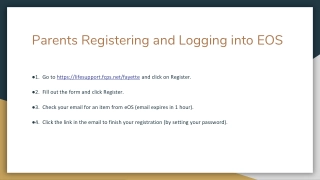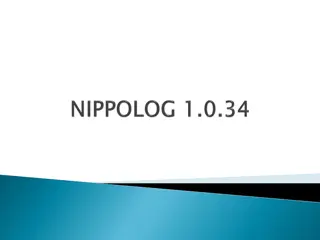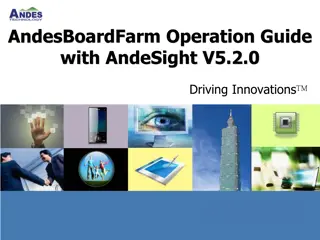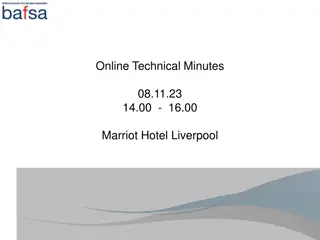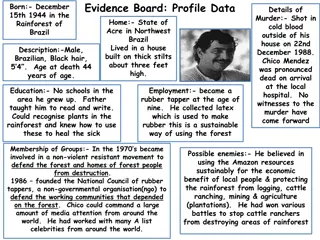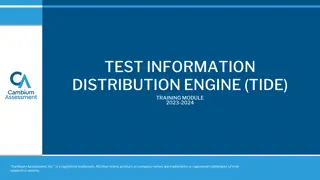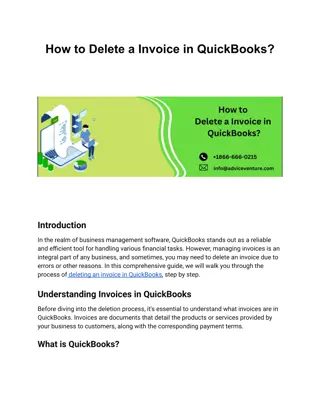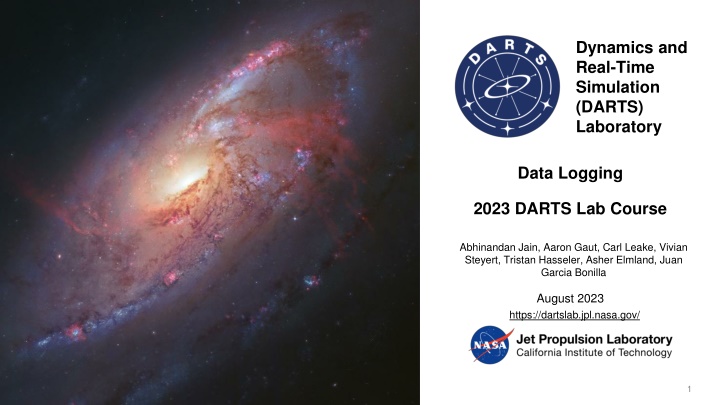
Advanced Data Logging Techniques for Real-Time Simulation Environments
Explore the significance of logging in simulations, its benefits, requirements, and a low-level logging solution using HDF5 data format for efficient data storage in real-time simulation environments.
Download Presentation

Please find below an Image/Link to download the presentation.
The content on the website is provided AS IS for your information and personal use only. It may not be sold, licensed, or shared on other websites without obtaining consent from the author. If you encounter any issues during the download, it is possible that the publisher has removed the file from their server.
You are allowed to download the files provided on this website for personal or commercial use, subject to the condition that they are used lawfully. All files are the property of their respective owners.
The content on the website is provided AS IS for your information and personal use only. It may not be sold, licensed, or shared on other websites without obtaining consent from the author.
E N D
Presentation Transcript
Dynamics and Real-Time Simulation (DARTS) Laboratory Data Logging 2023 DARTS Lab Course Abhinandan Jain, Aaron Gaut, Carl Leake, Vivian Steyert, Tristan Hasseler, Asher Elmland, Juan Garcia Bonilla August 2023 https://dartslab.jpl.nasa.gov/ https://dartslab.jpl.nasa.gov/ 1
Where does this topic fit in the big picture? Environment Terrain, Gravity Atmosphere, Ephemerides etc Closed-Loop Flight s/w Autonomy/Control Devices Thrusters, IMU, Cameras etc Analysis Data logging Parametric Monte Carlo Dynamics Rigid/flex bodies Articulation Attach/detach etc Sim Manager propagation, fsm, events Visualization 3D graphics stripcharts Geometry CAD parts Primitives Usability Introspection CLI, GUIs, Scripting Docs, Training Knowledge base Evolution R&D, new applications new tools & capabilities Deployment Bundling Porting Issue tracking S/W Mgmt Version control Build system Test suite Reusability Architecture Configurability Refactoring 2
Why do logging? Logging decouples simulation runs and post-analysis Analysis is often exploratory; with logging, analysis requirements can change without needing to rerun the simulation Use case: run multiple simulations in parallel and perform aggregate analysis on the logged data 3
Logging requirements Requirements Low I/O overhead Memory efficient Uses a widely supported binary format that is scalable and portable 4
HDF5 data format HDF5 is a hierarchical binary data format Standard: open source, usable from Matlab, Mathematica, etc Scalable: can handle very large datasets; designed for efficient I/O; don t need to load the whole thing Portable Lossless 6
DLogger DLogger: low level data-logging solution Logs data to HDF5 data files C++ solution for speed Saves DVar spec nodes Save-as-you-go to avoid memory limitations Writes are batched for efficient I/O 7
Logging requirements More advanced logging requirements Allow logging of multiple tables of grouped data Allow control of logging by simulation events Be able to log virtually any variable in the simulation Log units 8
DataRecorder Our main solution for procedural data logging Can log to different backends DLogger (hdf5) CSVLogger (csv) Stripchart (live plots) Dump (prints to standard output) Easily extended with new backends Procedural interface for setting up logging in the simulation script 9
Specifying variables to record Recorder the main container class used in DataRecorder Group a group of DVars within a Recorder instance All simulation variables logged by DataRecorder must be DVars DVars are added to a group Convenience functions for setting up DVars 10
DataRecorder notebook (notebook: B-Preliminaries/14-DataRecorder) Standalone example of DataRecorder usage 11
Dwatch Dwatch is built on top of DataRecorder Saves DVar specs (most simulation variables) and Python functions Event and/or state based logging Config file setup Located in the DataRecorder module 12
Specifying variables to record Dwatch uses ONLY DVar spec strings Set up in Python using a configuration file The actual logging is done in C++ Full DVar spec strings, eg: .mbody.darts.bodies.Base.hinge.Q Strings that can be evaluated to produce DVar spec strings (ending in .specString() : body.parentHinge().subhinge(0).[ relVel ].specString() Spec strings are used to look up spec nodes that are passed down to Dlogger. 13
Dwatch HDF5 stack Dwatch-style configobj file(s), with includes Each file may have a select to indicate variables to log Textual descriptions of DVar specstrings for each log variable Dwatch (config file) Inputs: one top-level .cfg file Creates one Dwatch group per select in any included file Builds DVar strings for each log variable paramsFromDwatch (python) Various Recorder subclasses for different backends HDF5Recorder uses Dlogger for HDF5 logging Consists of Group s containing Dvars Recommended API for setting up logging procedurally DataRecorder Handles low-level HDF5 file creation (Single HDF5 file for multiple Dwatch groups/tables) Provides DLoggerTable class and APIs Writes DVar objects to HDF5 packet tables Dlogger (C++) 15
Specifying variables to record Most useful data is already available via specNodes, which are attached to most objects But what if we want to log something that isn t already available? 16
Specifying variables to record Solution: can also log Python functions May return strings, doubles, vector of doubles, etc... Dwatch will convert the function to a DVar (eg: PyDoubleLeaf) internally. Takeaway: most useful variables are already DVars, but if not, they can be converted to DVars, so all cases are covered. 17
Support for Python Functions Converting Python functions to DVar specs: Identify the type of result DVar Py*Leaf object state = """{ 'type' : 'string', 'maxLength': 20, 'function' : 'getCurrentState', 'description' : 'current fsm state', 'units': '', }""" Python function 18
Support for Unit Conversion Logging a DVar in different units: Type indicates a change of units minutes = """{ 'specString': '.Dshell.time', 'old_units': 'sec', 'new_units': 'minutes', 'scaleFactor': 1.0/60.0, }""" 'type' : 'doubleNewUnits', 19
Logging Interface Time-based logging Parse Dwatch .cfg files (spec string data, timing, and frequency) Create DataRecorder logging object Create Dshell event with logging object as client data Event controls start/stop time Event controls periodicity FSM Controlled Logging Parse Dwatch .cfg files Create DataRecorder logging object FSM takes control of logging object FSM controls logging with this logging object Register Dshell Event and delete event when complete (may include some timing info) FSM invokes logging object update() function as desired 20
Additional resources DataRecorder sphinx documentation QA 339: features of DwatchHDF5 QA 67: logging from simulations QA 695: getting DVars in different units QA 559: viewing logged data 21
Logging notebook (notebook: B-Preliminaries/15-Dwatch) Using Dwatch to log spec nodes 22
hdfview HDF5 is a binary format. This is preferable for speed, but it cannot simply be viewed in a text editor. The HDF group provides the hdfview tool Used to explore the contents of an HDF5 file GUI-based Available for Windows, OSX, Linux 24
Command-line tools Other command-line tools on Linux h5ls: Gets the content of a group within an HDF5 file. Like the Unix ls command, but for HDF5 groups instead of filesystem directories. h5dump: Dumps the content of a HDF5 file. Both can be configured with command line options. 25
Plotme Plotme is a python script used to plot the variables stored in an h5 file Uses h5 files from DataRecorder It has been used for two years to generate plots of the Venus and Earth simulations for the Venus Aerobot project Usage: $ python plotme -h usage: plotme [-h] [-fh5 [H5_FILE ...]] [-dxy [DIFFXY ...]] [-pxy [PLOTXY ...]] [-pxys [PLOTXYS ...]] [-rbt RBTHRESH] [-pf PLOTFREQ] [-pp PLOTPICKLE] [-l] [--compare-data [COMPARE_DATA ...]] [--component [COMPONENT ...]] [-i INFO] [-cmp] [--label] [-s] [--eps-ext] [--same-scale] [--save-dir SAVE_DIR] [--save-csv [SAVE_CSV ...]] 26
DataRecorder make-booklet make-booklet: create a PDF document from log files 27
DataRecorder make-booklet make-booklet: create a PDF document from log files Creates a time-series plot for each logged variable Lists any additional metadata Requires DLogger HDF5 logs Command line interface Optional parameters to tweak behavior If given multiple log files, plots shared variables together for comparison. Supports logged vector and string states Lives in the DataRecorder module 28
Multi-run example Entry Guidance Performance Chute deployment Mach-Q Box dispersions Landing dispersions 30
Multi-run requirements Parameter sweeps, reproducible randomness, and anything in between No coupling between distinct runs Job dispatch is flexible with respect to available computing resources and available batch processing capabilities The Knob and MultiRun classes satisfy these needs 31
Additional resources MultiRun sphinx documentation Knobs sphinx documentation Config file sphinx documentation 32
Backup 33
Post-analysis requirements Analysis library requirements: Fast and capable of handling large datasets Can import from HDF5 Fast to set up scripts: analysts shouldn t need to write C++ code. Has a library of common data operations There are many solutions: Matlab, Mathematica, Python. pandas is an open source Python solution that meets these requirements. 35
pandas DataFrame pandas implements the DataFrame data structure for tabular data with heterogenous columns. The function, read_hdf, creates a DataFrame object from an HDF5 table. 36
Some DataFrame operations pandas has a rich set of operations that may be performed on DataFrame objects. pandas has built-in plotting capabilities such as line plots, histograms, bar plots, scatter plots, and box plots. DataFrames are built on NumPy arrays, so the NumPy, SciPy, and Matplotlib libraries are compatible. 37
Additional resources pandas documentation QA 559: viewing logged data QA 68: how to carry out analysis 38
Knobs Requirement: Parameter sweeps, reproducible randomness, and anything in between A Knob object produces possible values for a simulation input. Subclasses of Knob produce different kinds of value sets. For example: ListKnob: a list of values for a parameter, to be exercised over a series of runs. UniformKnob: picks a random value from a given uniform distribution for each run. May be seeded for reproducibility. 39
Output area Requirements: No interference between distinct runs Each run needs distinct names for its output files. The MultiRun class facilitates this by providing a unique directory name to each run. More on the MultiRun class later 40
Multirun with batch processing Requirement: Flexible job dispatch Each system has it s own computing resources. Some systems come with batch processing capabilities (eg: on HPC clusters we use Portable Batch System (PBS) to create batch jobs). The base MultiRun class is a framework for executing multiple runs, but is not capable of launching new processes. Usage: Launch multiple processes. In each process, create a MultiRun object with a unique sequential run number. Suitable for systems that already have batch processing capabilities. 41
IPythonMultiRun Requirement: Flexible job dispatch On the other hand, many systems don t come with batch processing software. The IPythonMultiRun class is derived from MultiRun and adds functionality necessary to execute multiple runs in parallel. Creates an IPython cluster consisting of engines on a local machine or distributed over a series of remote machines via SSH. Runs are automatically dispatched to available engines across the cluster. 42
Recap Why do logging? Decouples simulation runs from analysis. How to do high performance logging with large datasets? Use HDF5 How to configure logging for a simulation? Use a DwatchHDF5 style config file How to enable logging in a simulation? Use setupDwatchHDF5 on the config file, then do one of the following: Pass the logging object to an FSM Create a Dshell event Manually call the update method 43
Recap Why are multi-run capabilities needed? Parametric sweeps Monte Carlo experiments Dealing with uncertainty How to vary parameters in a multi-run context? Use Knobs How to do a multi-run simulation? Use a config file together with Knobs and a MultiRun instance. If the system already has batch job capabilities, use those with MultiRun. Otherwise, use IPythonMultiRun to set up a cluster. 44
Recap What are the requirements for analysis? Good performance, HDF5 compatible, minimal developer overhead, and a strong library of functions. How to do analysis on logged data? Use pandas and fine-tune with NumPy, SciPy, and Matplotlib where necessary. 45
Questions to Address Why do logging? How to do high performance logging with large datasets? How to configure logging for a simulation? How to enable logging in a simulation? Why are multirun capabilities needed? How to vary parameters in a multirun context? How to do a multirun simulation? What are the requirements for analysis? How to do analysis on logged data? 46

